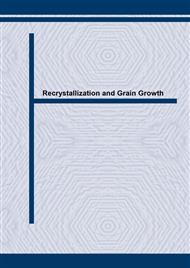[1]
F.J. Humphreys and M. Hatherly, Recovery after deformation, Ch. 5 in: Recrystallization and related annealing phenomena, (Pergamon Press, Oxford, 1996), p.127.
DOI: 10.1016/b978-0-08-041884-1.50012-x
Google Scholar
[2]
J.T. Michalak and H.W. Paxton, Trans. Met. Soc. of AIME, Vol. 221 (1961), p.850.
Google Scholar
[3]
R.A.L. Drew, W.B. Muir and W.M. Williams, Metals Technology, Vol. 11 (1984), p.550.
Google Scholar
[4]
L.N. Chaudhary and A.H. Qureshi, IEEE Trans. on Magnetics, Vol. 7 (1971), p.560.
Google Scholar
[5]
D.C. Jiles, NDT International, Vol. 10 (1988), p.311.
Google Scholar
[6]
Baldev Raj, V. Moorthy, T. Jayakumar and K.B.S. Rao, International Materials Reviews, 48 (2003), p.273.
Google Scholar
[7]
H. Traüble, The influence of crystal defects on magnetization processes in ferromagnetic single crystals in Magnetism and Metallurgy, Vol. 2, Ed. A.E. Berkowitz and E. Kneller, (Academic Press, New York, 1969), p.621.
Google Scholar
[8]
J. Sternberk, E. Kratochvílová, J. Hrebík and A. Gemperle, Phys. Stat. Sol. (a), Vol. 79 (1983), p.523.
Google Scholar
[9]
B. Astié, J. Degauque, J.L. Porteseil, R. Vergne, IEEE Trans. on Magnetics, MAG-17 (1981), p.2929.
Google Scholar
[10]
D. Kuhlmann, Z. Physik, 124 (1948), p.468.
Google Scholar
[11]
M. Verdier, Y. Brechet and P. Guyot, Acta Mater., 47(1) (1998), p.127.
Google Scholar
[12]
A. Martínez de Guerenu, Ph. D. Thesis, Universidad de Navarra, San Sebastián, in progress.
Google Scholar
[13]
A. Martínez de Guerenu, F. Arizti , M. Díaz-Fuentes and I. Gutiérrez, Recovery during annealing in a cold rolled low carbon steel. Part I: Kinetics and microstructural characterization, Acta Mater. Accepted for publication.
DOI: 10.1016/j.actamat.2004.04.019
Google Scholar
[2]
H. Hu, Annealing of silicon-iron single crystals,: in Recovery and Recrystallization of Metals, Ed. L. Himmel, (Science publishers, New York, 1963), p.311; L.N. Chaudhary and A.H. Qureshi, IEEE Trans. on Magnetics, 7(3) (1971).
Google Scholar
[15]
J.G. Byrne, Ch 3, Recovery in: Recovery, recrystallization and grain growth, (The Macmillan Co., New York, 1965), p.37.
Google Scholar
[16]
A. Martínez de Guerenu, F. Arizti and I. Gutiérrez, Recovery during annealing in a cold rolled low carbon steel. Part II: Modelling kinetics, Acta Mater. Accepted for publication.
DOI: 10.1016/j.actamat.2004.04.020
Google Scholar


